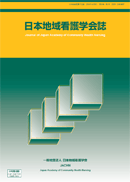Volume 13, Issue 1
Displaying 1-9 of 9 articles from this issue
- |<
- <
- 1
- >
- >|
-
Article type: Article
2010 Volume 13 Issue 1 Pages 37-43
Published: October 15, 2010
Released on J-STAGE: April 20, 2017
Download PDF (1061K) -
Article type: Article
2010 Volume 13 Issue 1 Pages 44-51
Published: October 15, 2010
Released on J-STAGE: April 20, 2017
Download PDF (1201K) -
Article type: Article
2010 Volume 13 Issue 1 Pages 52-58
Published: October 15, 2010
Released on J-STAGE: April 20, 2017
Download PDF (962K) -
Article type: Article
2010 Volume 13 Issue 1 Pages 59-67
Published: October 15, 2010
Released on J-STAGE: April 20, 2017
Download PDF (1298K) -
Article type: Article
2010 Volume 13 Issue 1 Pages 68-75
Published: October 15, 2010
Released on J-STAGE: April 20, 2017
Download PDF (1153K) -
Article type: Article
2010 Volume 13 Issue 1 Pages 76-82
Published: October 15, 2010
Released on J-STAGE: April 20, 2017
Download PDF (1303K) -
Article type: Article
2010 Volume 13 Issue 1 Pages 83-90
Published: October 15, 2010
Released on J-STAGE: April 20, 2017
Download PDF (1085K) -
Article type: Article
2010 Volume 13 Issue 1 Pages 91-99
Published: October 15, 2010
Released on J-STAGE: April 20, 2017
Download PDF (1110K) -
Article type: Article
2010 Volume 13 Issue 1 Pages 100-110
Published: October 15, 2010
Released on J-STAGE: April 20, 2017
Download PDF (1993K)
- |<
- <
- 1
- >
- >|
